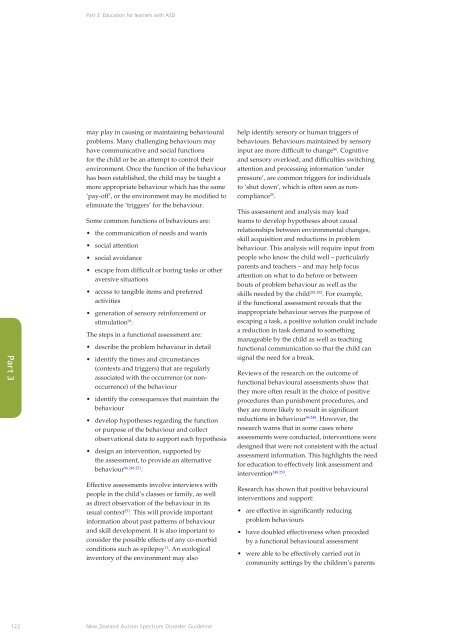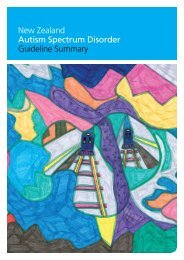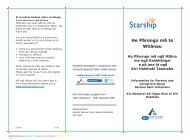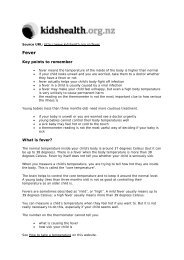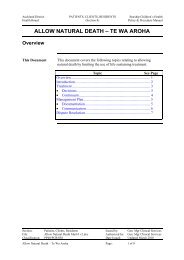New Zealand Autism Spectrum Disorder Guideline - Ministry of Health
New Zealand Autism Spectrum Disorder Guideline - Ministry of Health
New Zealand Autism Spectrum Disorder Guideline - Ministry of Health
You also want an ePaper? Increase the reach of your titles
YUMPU automatically turns print PDFs into web optimized ePapers that Google loves.
Part 3: Education for learners with ASD<br />
Part 3<br />
may play in causing or maintaining behavioural<br />
problems. Many challenging behaviours may<br />
have communicative and social functions<br />
for the child or be an attempt to control their<br />
environment. Once the function <strong>of</strong> the behaviour<br />
has been established, the child may be taught a<br />
more appropriate behaviour which has the same<br />
‘pay-<strong>of</strong>f’, or the environment may be modified to<br />
eliminate the ‘triggers’ for the behaviour.<br />
Some common functions <strong>of</strong> behaviours are:<br />
• the communication <strong>of</strong> needs and wants<br />
• social attention<br />
• social avoidance<br />
• escape from difficult or boring tasks or other<br />
aversive situations<br />
• access to tangible items and preferred<br />
activities<br />
• generation <strong>of</strong> sensory reinforcement or<br />
stimulation 96 .<br />
The steps in a functional assessment are:<br />
• describe the problem behaviour in detail<br />
• identify the times and circumstances<br />
(contexts and triggers) that are regularly<br />
associated with the occurrence (or nonoccurrence)<br />
<strong>of</strong> the behaviour<br />
• identify the consequences that maintain the<br />
behaviour<br />
• develop hypotheses regarding the function<br />
or purpose <strong>of</strong> the behaviour and collect<br />
observational data to support each hypothesis<br />
• design an intervention, supported by<br />
the assessment, to provide an alternative<br />
behaviour 96 248 251 .<br />
Effective assessments involve interviews with<br />
people in the child’s classes or family, as well<br />
as direct observation <strong>of</strong> the behaviour in its<br />
usual context 251 . This will provide important<br />
information about past patterns <strong>of</strong> behaviour<br />
and skill development. It is also important to<br />
consider the possible effects <strong>of</strong> any co-morbid<br />
conditions such as epilepsy 11 . An ecological<br />
inventory <strong>of</strong> the environment may also<br />
help identify sensory or human triggers <strong>of</strong><br />
behaviours. Behaviours maintained by sensory<br />
input are more difficult to change 96 . Cognitive<br />
and sensory overload, and difficulties switching<br />
attention and processing information ‘under<br />
pressure’, are common triggers for individuals<br />
to ‘shut down’, which is <strong>of</strong>ten seen as noncompliance<br />
25 .<br />
This assessment and analysis may lead<br />
teams to develop hypotheses about causal<br />
relationships between environmental changes,<br />
skill acquisition and reductions in problem<br />
behaviour. This analysis will require input from<br />
people who know the child well – particularly<br />
parents and teachers – and may help focus<br />
attention on what to do before or between<br />
bouts <strong>of</strong> problem behaviour as well as the<br />
skills needed by the child 251 252 . For example,<br />
if the functional assessment reveals that the<br />
inappropriate behaviour serves the purpose <strong>of</strong><br />
escaping a task, a positive solution could include<br />
a reduction in task demand to something<br />
manageable by the child as well as teaching<br />
functional communication so that the child can<br />
signal the need for a break.<br />
Reviews <strong>of</strong> the research on the outcome <strong>of</strong><br />
functional behavioural assessments show that<br />
they more <strong>of</strong>ten result in the choice <strong>of</strong> positive<br />
procedures than punishment procedures, and<br />
they are more likely to result in significant<br />
reductions in behaviour 96 248 . However, the<br />
research warns that in some cases where<br />
assessments were conducted, interventions were<br />
designed that were not consistent with the actual<br />
assessment information. This highlights the need<br />
for education to effectively link assessment and<br />
intervention 248 253 .<br />
Research has shown that positive behavioural<br />
interventions and support:<br />
• are effective in significantly reducing<br />
problem behaviours<br />
• have doubled effectiveness when preceded<br />
by a functional behavioural assessment<br />
• were able to be effectively carried out in<br />
community settings by the children’s parents<br />
122<br />
<strong>New</strong> <strong>Zealand</strong> <strong>Autism</strong> <strong>Spectrum</strong> <strong>Disorder</strong> <strong>Guideline</strong>


